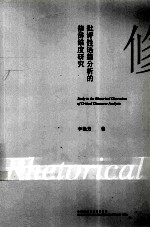图书介绍
批评性语篇分析的修辞维度研究PDF|Epub|txt|kindle电子书版本网盘下载

- 李艳芳著 著
- 出版社: 北京:外语教学与研究出版社
- ISBN:9787513511520
- 出版时间:2012
- 标注页数:198页
- 文件大小:5MB
- 文件页数:148页
- 主题词:英语-修辞学-研究-英文
PDF下载
下载说明
批评性语篇分析的修辞维度研究PDF格式电子书版下载
下载的文件为RAR压缩包。需要使用解压软件进行解压得到PDF格式图书。建议使用BT下载工具Free Download Manager进行下载,简称FDM(免费,没有广告,支持多平台)。本站资源全部打包为BT种子。所以需要使用专业的BT下载软件进行下载。如BitComet qBittorrent uTorrent等BT下载工具。迅雷目前由于本站不是热门资源。不推荐使用!后期资源热门了。安装了迅雷也可以迅雷进行下载!
(文件页数 要大于 标注页数,上中下等多册电子书除外)
注意:本站所有压缩包均有解压码: 点击下载压缩包解压工具
图书目录
Chapter 1 Introduction1
1.1 Origin and Rationale for the Present Study1
1.2 Objectives of the Present Study7
1.3 Research Methodology8
1.4 Organization of the Dissertation9
Chapter 2 Literature Review13
2.1 Intellectual Background for CDA13
2.1.1 Linguistic Turn in Intellectual Climate13
2.1.2 Rhetorical Turn in Discourse Studies15
2.1.3 Critical Turn in the Study of Discourse17
2.2 CDA:An Overview18
2.2.1 Genesis of Critical Discourse Analysis18
2.2.2 A Diverse Picture of Research on CDA abroad21
2.2.3 Research on CDA at Home23
2.2.4 Research on Metaphor in CDA23
2.2.5 Critical Response to CDA25
2.3 Introduction of the Rhetorical Perspective28
2.3.1 Discourse Analysis and Rhetorical Criticism:Where They Converge and Diverge30
2.3.2 Shared Focus between CDA and Critical Rhetoric32
2.4 Summary33
Chapter 3 Theoretical Preliminaries34
3.1 Defining Key Concepts34
3.1.1 Discourse34
3.1.2 Power37
3.1.3 Ideology38
3.1.4 Being Critical42
3.2 Ideology and the Social Construction of Meaning43
3.2.1 The Critical Turn in the Study of Communication43
3.2.2 Language as a Site of Social Struggle45
3.2.3 Ideology as a Conceptual Link between Communication and Power47
3.3 The Possibility of Rhetorical Intervention51
3.4 Ideology,Symbolic Action and Agency53
3.5 Summary56
Chapter 4 Rhetoric,Power and Ideology57
4.1 An Evolving Conception of Rhetoric58
4.1.1 A Glimpse of Classical Rhetoric58
4.1.2 An Overview of Rhetoric in Contemporary Times60
4.1.3 Three Perspectives of Rhetorical Studies61
4.2 Problematizing "Rhetoric as Epistemic"62
4.3 From a Pragmatic View of Rhetoric to Rhetorical Materialism64
4.3.1 A Turn in Rhetorical Paradigm64
4.3.2 An Anatomy of Rhetorical Materialism66
4.3.3 Comparing a Pragmatic Theory of Rhetoric and Rhetorical Materialism68
4.4 A Running Theme in Rhetoric69
4.4.1 The Self-effacement of Rhetoric69
4.4.2 Rhetoric and Power74
4.4.2.1 Rhetoric as Power Articulation74
4.4.2.2 The Rhetorical Logic of Power75
4.4.3 Rhetoric and Ideology76
4.4.3.1 The Internal Modes of Operation of Ideology76
4.4.3.2 Rhetoric as Carrier and Demystifier of Ideology81
4.5 Etho as the Nexus between Rhetoric and CDA84
4.5.1 Etho in Classical Rhetoric84
4.5.2 Cambell's Theorizing of Etho88
4.5.3 Postmodern Etho90
4.6 Summary91
Chapter 5 Deconstruction and Reconstruction:Kenneth Burke's Implication for CDA93
5.1 Kenneth Burke and Rhetoric as Symbolic Action94
5.1.1 A Synoptic View of Burke94
5.1.2 Language as Metaphorical Selection95
5.1.3 Terministic Screens as Constitutive of Rhetoric100
5.2 Kenneth Burke's Dramatistic Pentad102
5.2.1 The Power of Naming102
5.2.2 Dramatism103
5.2.3 The Paradoxical Term of Substance108
5.3 A Rhetoric of Motives:Identification and Consubstantiality110
5.4 The Burkean Framework:Deconstruction and Reconstruction112
5.4.1 Kenneth Burke the Ideologist112
5.4.2 Incorporation of Marx and Freud in the Rhetorical Framework116
5.4.3 Reflection on Burkean New Rhetoric117
5.5 Burke's Continued Relevance to Our Discussion of CDA119
5.5.1 The Rhetoricality of CDA119
5.5.2 Rhetorical Equipment for Living120
5.6 Summary123
Chapter 6 Metaphor as Terministic Screen125
6.1 Three Perspectives on the Relationship between Metaphor and "Reality"126
6.1.1 Description-oriented View of Metaphor126
6.1.2 Constitution-oriented View of Metaphor127
6.1.3 Deconstructive View of Metaphor129
6.2 Metaphor through Rhetorical Lens130
6.2.1 Metaphor as Formal Identification130
6.2.2 Rhetorical Constitution of Metaphors132
6.2.2.1 Metaphor as Naming133
6.2.2.2 Metaphor as Enthymeme136
6.2.2.3 Metaphors as Arguments138
6.3 Ideological Dimensions of Metaphor140
6.3.1 Metaphor,Ideology and Thought140
6.3.2 Metaphor as a Central Strategy for Both Legitimisation and Delegitimisation143
6.3.3 Metaphor as Evaluation145
6.3.4 Metaphor and Myth146
6.4 Summary147
Chapter 7 Theoretical Model in Action148
7.1 Metaphor Analysis149
7.1.1 Case One:Reports on Columbia High School Shooting149
7.1.2 Case Two:Key Metaphors Circulating in Post 9/11 Discourse150
7.1.2.1 Introductory Remarks150
7.1.2.2 The War Metaphor:How It Takes Shape in the President's Address151
7.1.2.3 The Metaphorical Nature of "War"154
7.1.2.4 War Metaphor as a "Double-Edged Sword"156
7.1.2.5 Axis of Evil157
7.1.2.6 War against Islamic Fascism158
7.1.2.7 Summary160
7.2 Pentad Analysis162
7.2.1 Introductory Remarks162
7.2.2 Analyzing the President's Speech with Dramatic Pentad163
7.2.3 Hidden Ideology at Work167
7.3 Summary169
Chapter 8 Conclusions and Implications171
8.1 Major Findings and Contributions171
8.2 Pedagogical Implications173
8.3 Limitations of the Research174
8.4 Areas for Future Research174
Appendix176
Bibliography185